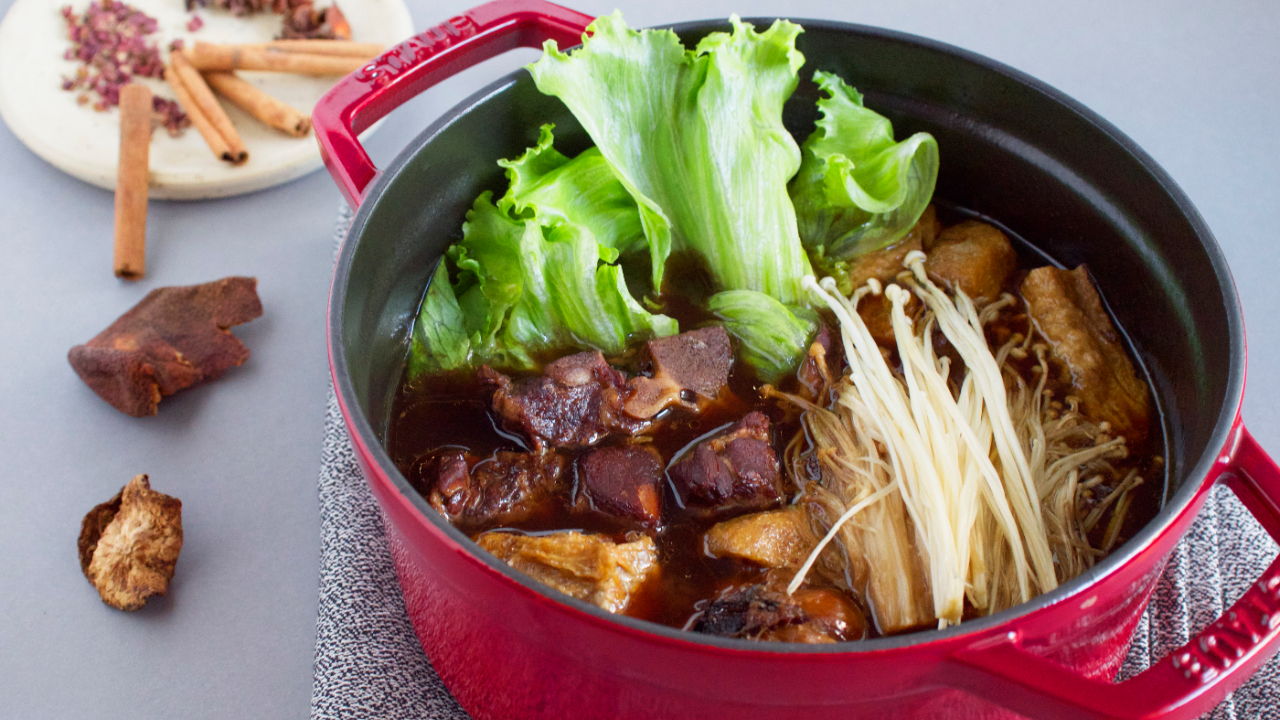Bak kut teh means ‘meat bone tea’ in the Chinese Hokkien dialect. To be exact, the term ‘bak’ refers to pork. That is the meat that is originally used in the broth. It’s a comforting dish that is often enjoyed with yam rice.
This stew is special because of the Chinese herbs such as Dang Gui (Chinese angelica root). Star anise, cloves and smoked garlic make this dish very flavourful. Usually, bak kut teh is served with rice, vegetables and 'you tiao' (sometimes known as Chinese churros).
These days, chicken is also used as a substitute too. The dish is made by boiling different parts of the pork together with a variety of aromatics and Chinese herbs.
Differences between Malaysian and Singaporean bak kut teh
There are differences between the Hokkien version of bak kut teh which is commonly found in Malaysia when compared to the Teochew version in terms of colour, level of saltiness and of course the taste.
| Type | Colour | Saltiness | Taste |
|---|---|---|---|
| Hokkien (Malaysia) | Dark | Salty | Herby |
| Teowchew (Singapore) | Light | Less salty | Peppery |
Best pork parts
The best pork part has got to be pork ribs. Ribs are also rich in collagen, giving the broth a silky and flavourful mouth-feel. I love adding some chunks of should too for a more meaty bite. It’s also fattier compared to pork loins and less fatty than pork belly.
Where to purchase bak kut teh herbs
Pre-packed herbs are widely available in Malaysia or Asian grocers offering Malaysian ingredients. If you want to make bak kut teh from scratch instead of using pre-packed herbs, this is all the information you will need.
Bak kut teh herbs are simply Chinese medicinal herbs that are found in most Chinese medicinal halls or at Asian grocers around the world. The herbs listed below can be individually sought in the mentioned stores.
In almost all Asian grocers, you will be able to find packs of 10 herbs usually marketed as ‘Chinese Herbal Soup Mix’ or ‘Chinese Tonic Soup’.
Bak Kut Teh herbs
In the table below, you will find the names of the ingredients in English, Chinese characters and pinyin. For a decent pot of bak kut teh, you will need at least 6 types of herbs.
| Herbs Name | Pinyin | Chinese characters |
|---|---|---|
| Foxglove root | Shu di huang | 熟地黄 |
| Chinese angelica root | Dang gui | 當歸 |
| Szechuan lovage | Chuang gong | 川芎 |
| Solomon's Seal | Yu zhu | 玉竹 |
| Red dates | Hong zao | 红枣 |
| Goji berries | Gou qi zi | 枸杞子 |
Other additional ingredients which are used in the recipe are the more common herbs which add more flavours and medicinal benefits to the soup.
| Herbs Name | Pinyin | Chinese characters |
|---|---|---|
| Dried orange peel | Chen pi | 陈皮 |
| Liquorice root | Gan cao | 甘草 |
| Codonopsis pilosula | Dang shen | 黨參 |
| Black dates | Nan zao | 正南枣 |
Besides Chinese herbs, aromatics and spices such as Sichuan pepper, fennel seeds and cloves are highly important to contribute to the aroma and flavours for which bak kut teh is known for.
Duration to boil bak kut teh
In this recipe, it is recommended to boil bak kut teh for four hours. If you are running short of time, two hours would be sufficient. However, the broth would taste much better if boiled for four hours.
Secrets tip for extra flavourful BKT
Bak kut teh tastes better after boiling for 4 hours and allowing to rest overnight in the refrigerator. This was a secret tip shared by one of the best restaurants in Klang when asked about the secret to its popular bak kut teh.
There is indeed a big difference in taste after letting the broth settles and allowing the ingredients to release their flavours.
Allow the dish to cool to room temperature before keeping it in the refrigerator. It can be kept for up to 5 days but the flavours would be best if it is consumed the very next day.
Do not leave bak kut teh at room temperature for more than 2 hours. According to the United States Department of Agriculture Food Safety and Inspection Service (USDA), food left above 4.4 Celsius (40 Fahrenheit) should not be consumed as it is considered unsafe.
Separate broth with other ingredients
Usually, bak kut teh is served with vegetables (romaine lettuce, iceberg lettuce, bok choy) tofu puffs, fried bean curd skin and mushrooms (enoki, shiitake).
These ingredients should be added to the dish shortly before serving. If you are unable to finish the dish in one sitting, these additional ingredients should be cooked with a portion of the broth separately to avoid spoiling the taste of the rest of the soup.
Tips for tender pork
Here are two secrets to having tender meat in bak kut teh. It is important to keep the heat low while stewing the dish. Allow it to simmer for a few hours so that the meat will become tender and falls off the bone easily.
Additionally, using a cast iron dutch oven will also guarantee that the meat would be tender and the broth flavourful. This is due to the heavy lid which prevents the broth from evaporating too much.
The outcome is a very flavourful broth with soft and tender pork.

